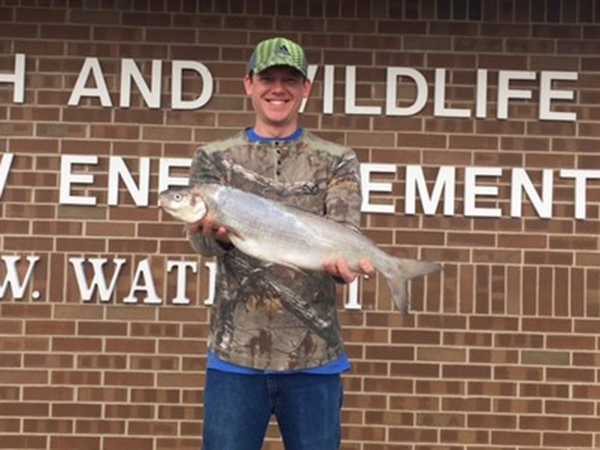- Details
(Provided by IDNR)
 Josh Pisowicz with Record-Breaking Whitefish
Josh Pisowicz with Record-Breaking Whitefish
Josh Pisowicz with Record-Breaking Whitefish
The Indiana record for whitefish has been broken twice in two weeks by anglers fishing Lake Michigan.
Josh Pisowicz was targeting whitefish on Feb. 19 on the Michigan City pier and caught a 5-pound, 9-ounce specimen. Pisowicz submitted a record fish application to DNR officials, and they certified the next day that his fish beat the previous record, set in 2015 by Dan Rostecki, by 1 ounce.
Then, on Feb. 28, Alexander Ciesielski submitted a record fish application for a 5-pound, 13-ounce whitefish he caught near Portage Lakefront Park on Jan. 21. Ciesielski was not targeting whitefish but knew as soon as he landed it that he had a record contender. DNR officials certified Ciesielski's record on March 3.
- Details
(Provided by IDNR)<
The Indiana "Where to Fish Finder," an interactive map of public access boat ramps, now includes fish survey reports to keep anglers informed.
The map is at wildlife.IN.gov/3591.htm.
Fish survey reports summarize the species collected by number and size, how the sport fish in a specific waterbody compare to those in other waters, and include depth maps and information on water quality and submersed vegetation.
- Details
LureCraft Fisherman’s Shop will conduct its annual customer appreciation days March 3-4 at the Orland, Ind. store.
Roger Hinchcliff will be doing steelhead fishing seminars throughout the day. In addition to special bargains on lure making supplies, visitors will get to tour the shop and see how some items are made.
Hours are 7 a.m.-8 p.m. Friday and 8 a.m.-4 p.m. Saturday. Free coffee and donuts will be available in the morning and hotdogs at lunch.
- Details
Salmon and smallmouth bass seminars are scheduled for the Hammond Knights of Columbus Hall March 4.
Captains Ralph Steiger and John Warren of King Seeker Charters will cover trolling and casting tactics from 10 a.m. to 2 p.m. while Steiger and Ryan Whitacre will outline advance tactics for smallmouth bass on Lake Michigan. At 4 p.m.
Price of each seminar is $40. Meals are available. For more information, visit www.captsteiger.com.
- Details
(Provided by IDNR)
The Indiana DNR will be sharing information about white-tailed deer with a hunting group that is organizing a pilot program aimed at gathering public input for consideration in future deer management decisions.
The group - Indiana White-tailed Deer Herd Management (IWDHM) - is putting together county deer advisory councils, or CDACs, in a handful of counties. The pilot program is modeled after one that operates in Wisconsin.
In addition to local hunters, CDACs are expected to include representation from agriculture, forestry, local government, tourism, transportation, non-consumptive users, and a disease monitoring organization.
The DNR will provide the CDACs with information the agency already collects on an annual basis, including harvest data, crop depredation damage, forest damage, and deer-vehicle collision statistics.
CDAC meetings will gather public input on deer population goals and antlerless quotas for that county and share it with the DNR.


